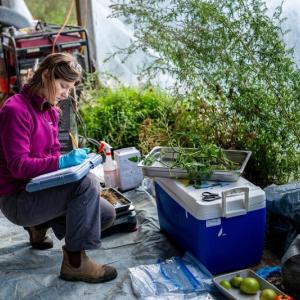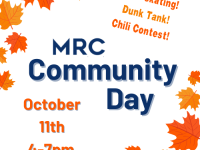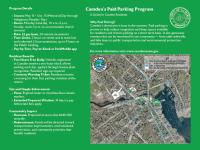UMaine research highlights how PFAS uptake differs among crops
 University of Maine Ph.D. student Alex Scearce studies PFAS absorption by tomatoes at a farm in Unity, Maine, in 2023. She led a recent study in which she and her colleagues show the different ways in which specific produce and crops take up PFAS. (Photo courtesy University of Maine)
University of Maine Ph.D. student Alex Scearce studies PFAS absorption by tomatoes at a farm in Unity, Maine, in 2023. She led a recent study in which she and her colleagues show the different ways in which specific produce and crops take up PFAS. (Photo courtesy University of Maine)
 (Photo courtesy University of Maine)
(Photo courtesy University of Maine)
 University of Maine Ph.D. student Alex Scearce studies PFAS absorption by tomatoes at a farm in Unity, Maine, in 2023. She led a recent study in which she and her colleagues show the different ways in which specific produce and crops take up PFAS. (Photo courtesy University of Maine)
University of Maine Ph.D. student Alex Scearce studies PFAS absorption by tomatoes at a farm in Unity, Maine, in 2023. She led a recent study in which she and her colleagues show the different ways in which specific produce and crops take up PFAS. (Photo courtesy University of Maine)
 (Photo courtesy University of Maine)
(Photo courtesy University of Maine)
One way people ingest a group of toxic chemicals known as PFAS is through consuming produce, dairy and meat products that have been exposed to contaminated soil and irrigation water. Some guidance is available on how growers can try to mitigate the uptake of PFAS, but it’s limited due in part to a lack of research on which chemicals enter what crops, how they are absorbed, where in the plants they accumulate and at what concentrations.
In a study published in Environmental Advances, University of Maine researchers show the different ways in which specific produce and crops take up PFAS, often referred to as “forever chemicals,” from contaminated soil.
PFAS have been used widely in industrial and consumer products such as nonstick pans, takeout food containers, firefighting foam and certain personal care products since the 1940s for their resistance to grease, oil, water and heat. These chemicals, however, can persist in the environment for hundreds of years, break down slowly and pose health risks. Current research suggests that exposure to certain levels of some PFAS may lead to immune system disorders, thyroid hormone disruption, cancer and other adverse health outcomes.
Alex Scearce, a Ph.D. student in ecology and environmental sciences at UMaine who led the study, and her colleagues hope their findings can help policymakers and producers further prevent the spread of these toxic chemicals in food systems.
“This study shows that there is no one-size-fits-all recommendation or policy for farmers dealing with PFAS contamination. The crop physiology, PFAS compounds present in the soil, mode of contamination, time since contamination, soil characteristics and management practices all shape PFAS uptake into crops,” said Scearce. “This is why ongoing PFAS research is important — because we know these factors are affecting the results we see, but we still lack clarity on how they play out in a real agricultural operation when they’re interacting.”
The study is one of many examples of collaborative PFAS research and outreach projects as part of the university-wide efforts to quickly and effectively address solutions for forever chemicals. Early support from American Farmland Trust helped Scearce and UMaine faculty secure additional funding and begin interdisciplinary, experimental research in less time.
“As a nationally connected non-profit organization taking a holistic approach to agriculture, we work at the interface of protecting farmland, keeping farmers and ranchers who manage that land working and promoting sound agricultural systems. PFAS are a critical challenge to that entire system. American Farmland Trust quickly identified University of Maine researchers as strong partners in investigating how farmers in Maine and beyond can respond to the challenge,” said Bianca Moebius-Clune, AFT national director of climate and soil health. “The funding provided to the University of Maine is unique — the intention was specifically to jumpstart research that will be directly relevant to farmers making decisions about their PFAS impacted land.”
Working out of University of Maine Cooperative Extension’s Diagnostic and Research Laboratory in Orono, Scearce and her colleagues used three types of plants — lettuce, tomato and tall fescue, a low turf grass used as livestock feed — to evaluate how they take up PFAS from the soil. These plants were grown using soil that was intentionally mixed with four types of PFAS and tested for four to six weeks. They examined the types and quantities of PFAS each crop took up, as well as where in the plants they were found.
On average, the quantity and types of PFAS each crop took up and where they were located within the plant were largely determined by the chemical composition of these pollutants, particularly the length of their carbon atom chains, known as the chain length.
Long-chain PFAS were often more concentrated in the roots. These types of PFAS, which were phased out of new product development a decade ago, are typically known to be more toxic and break down more slowly but are less mobile. Meanwhile, higher concentrations of short-chain PFAS were typically found in the leaves and fruits — the edible portions of each plant tested in the study. These types of PFAS, which were created as a less-toxic replacement for long-chain PFAS, break down faster but are more mobile. The exception to this pattern was noted in lettuce, which contained higher concentrations of both longer and shorter-chain PFAS in their leaves than in their roots.
“It is expensive to test for PFAS, and the cost of testing is normally out of reach for many farmers. We hope that by testing crops that Maine farmers grow for sale, we can help show which crops are likely to be ‘high risk’ versus those that are ‘low risk’. While our study is not the end of the story, it starts to provide farmers with an idea of what they can grow if their soils are contaminated with specific types of PFAS,” said Rachel Schattman, Scearce’s advisor, study co-author and associate professor of sustainable agriculture at UMaine.
For three of the four types of PFAS tested, the highest concentrations were found in tall fescue, followed by lettuce and tomatoes. However, concentrations of one type of chemical called perfluorobutanoate (PFBA), a short-chain PFAS linked to thyroid and liver issues in animals, were the highest by far in tomato fruits, followed by tall fescue and lettuce.
The study also highlights how certain farming methods like intercropping — planting multiple crops in the same area — aren’t reliable solutions for preventing the uptake of PFAS by crops, or at least not by these crops. In every intercropped treatment tested, uptake was increased into the edible portion, with the exception of some mitigation of concentrations in the tomato fruits when they were planted alongside lettuce.
"Reducing risk of contamination via careful crop selection and planting strategies are of interest to growers because these approaches, known as phytomanagement, may allow farmers to sustain food production on contaminated land. This study showed that planting strategies and species do matter, but there is more research needed on what species and what combinations are effective,” said Scearce.
In addition to Scearce and Schattman, other study authors include Jean MacRae; associate professor of civil and environmental engineering; Yong-Jiang Zhang, former associate professor of applied plant physiology; Caleb Goossen from the Maine Organic Farmers and Gardeners Association, and Kylie Holt from the School of Life Sciences at the University of Hawai'i Mānoa.
This work received funding and support from American Farmland Trust, the Maine Organic Farmers and Gardeners Association, the Maine Farmland Trust and the USDA National Institute of Food and Agriculture through the Maine Agricultural and Forest Experiment Station. Scearce-PFAS-research: University of Maine Ph.D. student Alex Scearce, pictured working at a farm in Unity, Maine, in 2023, led a recent study in which she and her colleagues show the different ways in which specific produce and crops take up PFAS. Photo courtesy of the University of Maine.
About the University of Maine
As Maine’s only public research university and a Carnegie R1 top-tier research institution, the University of Maine advances learning and discovery through excellence and innovation. Founded in 1865 in Orono, UMaine is the state’s land, sea and space grant university with a regional campus at the University of Maine at Machias. Our students come from all over the world and work with faculty conducting fieldwork around the globe — from the North Atlantic to the Antarctic. Located on Marsh Island in the homeland of the Penobscot Nation with UMaine Machias located in the homeland of the Passamaquoddy Nation, UMaine’s statewide mission is to foster an environment that creates tomorrow’s leaders. As the state’s flagship institution, UMaine offers nearly 200 degree programs through which students can earn bachelor’s, master’s, professional master’s and doctoral degrees as well as graduate certificates. For more information about UMaine and UMaine Machias, visit umaine.edu/about/quick-facts/ and machias.edu/about-umm/umm-facts/.
























